When you walk into a store, you might think that the way products are arranged on the shelves is random or purely aesthetic. However, there is a science behind it - one that significantly influences consumer behavior and sales. This science is known as shelf space planning and mastering it can make a noticeable difference in your store’s revenue.
The Psychology Behind Shelf Placement
Understanding how consumers perceive and interact with products on shelves is key to optimizing product placement. Following are some psychological factors to consider:

- Eye-level is buy-level: Products placed at eye level tend to sell more because they are within the customer’s direct line of sight. This prime shelf real estate should be reserved for high-margin or best-selling items to maximize profits.
- Impulse purchases: Placing small, low-cost items near the checkout area or along the path to it can trigger impulse buys. These items do not require much thought or commitment, making them easy additions to a shopping cart.
- The Power of three: Shoppers are drawn to groups of three products. Whether it is a trio of similar items or a set of complementary products, arranging items in threes can create a visual appeal that encourages purchase.
- Color psychology: Bright colors attract attention, while neutral tones can create a sense of calm and sophistication. Understanding color psychology can help retailers arrange products in a way that aligns with your brand and the emotions they want to evoke in customers.
The Role of Planograms
A planogram is a diagram that dictates the placement of products on shelves, designed to maximize sales and improve the shopping experience. Here is how they help:
- Optimizing space: Planograms ensure every inch of shelf space is used efficiently. By carefully planning product placement, you can avoid overcrowding while ensuring that key products stand out.
- Product grouping: Grouping similar or complementary products together not only makes it easier for customers to find what they need, but it also encourages cross-selling. For example, placing chips near dips or pasta next to sauces can increase the likelihood of customers buying multiple items.
- Data-driven decisions: Planograms are often created based on sales data and customer behavior insights. This means that they are not static; they can be adjusted based on what is selling and what is not. By continually refining your planogram, you can keep your shelves working as hard as possible to drive sales.
- Increased product visibility: When products are placed strategically, they are more likely to attract the customer’s attention. This increased visibility can lead to higher sales, especially for new or promotional items.
- Improved customer experience: A well-organized shelf makes it easier for customers to find what they are looking for, which enhances their shopping experience. Satisfied customers are more likely to make repeat purchases and recommend your store to others.
- Analyze sales data: Use your sales data to identify which products are your top performers and which are lagging. This will help you decide which items deserve the best shelf placement.
Overview of Nexgen POG
Nexgen POG is a robust and user-friendly cloud-based visual merchandising tool. It is designed for quick and efficient planogramming with minimal effort. Planogram in retail can be designed by easily dragging and dropping the products. The multi-device compatibility feature of POG allows you to obtain, share and edit planogram on any device, including your phone. It helps in designing store-specific planograms for increased product visibility and sales.
Get Your Free Trial Now!